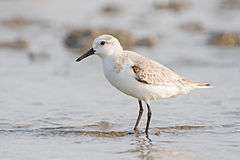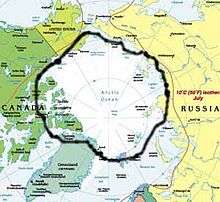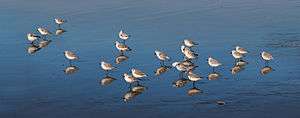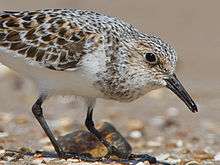Sanderling
| Sanderling | |
|---|---|
 | |
| Non-breeding plumage, Laem Phak Bia, Phetchaburi, Thailand | |
_breeding_plumage.jpg) | |
| Breeding plumage, Farmoor Reservoir, Oxfordshire | |
| Scientific classification | |
| Kingdom: | Animalia |
| Phylum: | Chordata |
| Class: | Aves |
| Order: | Charadriiformes |
| Family: | Scolopacidae |
| Genus: | Calidris |
| Species: | C. alba |
| Binomial name | |
| Calidris alba (Pallas, 1764) | |
 | |
| Sanderling breeding range. Black border marks southern limit. | |
| Synonyms | |
| |
The sanderling (Calidris alba) is a small wading bird. The name derives from Old English sand-yrðling, "sand-ploughman".[2] The genus name is from Ancient Greek kalidris or skalidris, a term used by Aristotle for some grey-coloured waterside birds. The specific alba is Latin for "white".[3]
It is a circumpolar Arctic breeder, and is a long-distance migrant, wintering south to South America, South Europe, Africa, and Australia. It is highly gregarious in winter, sometimes forming large flocks on coastal mudflats or sandy beaches.
It is somewhat unlike other sandpipers in appearance, which has led to the suggestion that it should be placed into a monotypic genus Crocethia. A more recent review (Thomas et al., 2004) indicates, however, that the sanderling is a fairly typical "stint" or small sandpiper and should be separated from the large knots with its closest relatives in a distinct genus.
This bird is similar in size to a dunlin, but stouter, with a thick bill. It shows a strong white wingbar in flight, and runs along the sandy beaches it prefers with a characteristic "bicycling" action of its legs, stopping frequently to pick small food items. It eats small crabs and other small invertebrates. In spring, birds migrating north from South America consume large numbers of horseshoe crab eggs in the Delaware Bay area.
In spring, the birds arrive on the High Arctic breeding grounds (see map), where they lay 3–4 eggs in a ground scrape. On the nesting grounds, these birds mainly eat insects and some plant material.
The sanderling was described by the German naturalist Peter Simon Pallas in 1764 and given the binomial name Trynga alba.[4][5][6]
The sanderling is one of the species to which the Agreement on the Conservation of African-Eurasian Migratory Waterbirds (AEWA) applies.
Description
The sanderling is a small plump sandpiper, 18–20 cm (7.1–7.9 in) in length. Its weight ranges from 40–100 g (1.4–3.5 oz). The winter bird is very pale, almost white apart from a dark shoulder patch. This is the source of the specific name, alba, which is the Latin for "white". Later in the summer, the face and throat become brick-red. The juvenile bird is spangled black and white, and shows much more contrast than the adult.
| Standard Measurements[7][8] | |
|---|---|
| length | 180–220 mm (7.1–8.7 in) |
| weight | 60 g (2.1 oz) |
| wingspan | 430 mm (17 in) |
| wing | 114.5–121.6 mm (4.51–4.79 in) |
| tail | 47.3–53 mm (1.86–2.09 in) |
| culmen | 22.5–26.6 mm (0.89–1.05 in) |
| tarsus | 23.5–25.8 mm (0.93–1.02 in) |
If its size is misjudged, a sanderling in breeding plumage can be mistaken for some varieties of stint, or a sanderling in winter plumage can be mistaken for a dunlin or red knot. It can be told from other small wading birds, given good views, by its lack of a hind toe. Its behavior is also distinctive.
Distribution, habitat and migration

The sanderling breeds in the High Arctic areas of North America, Europe and Asia. In North America, it breeds in the Canadian Arctic Archipelago, Nunavut, Greenland (and to a lesser extent Alaska). In Eurasia, it breeds in Spitsbergen and areas of northern Russia from the Taymyr Peninsula to the New Siberian Islands. In the northern winter, it has a nearly cosmopolitan distribution across the world's marine coasts. It is a complete migrant, travelling between 3,000 to 10,000 km (1,900 to 6,200 mi) from its breeding grounds to its wintering sites. Birds that travel further also arrive later and leave sooner. Most adults leave the breeding grounds in July and early August, whereas juvenile birds leave in late August and early September. The northward migration begins in March at the southern end of their winter distribution.[9]
The breeding habitat of the sanderling is coastal tundra north of 5 °C (41 °F) July isotherm. The species typically chooses nesting sites on dry stony areas near wet areas, from 60 m (200 ft) above sea level to 800 m (2,600 ft). During the winter and its migration, it is most commonly found on coastal sandy beaches, but also occurs on tidal sand flats, mud flats and the shores of lakes and rivers. More infrequently, it may occur on rocky shores.[9]
Subspecies
The sanderling consists of two subspecies:
- C. a. alba, (Pallas, 1764), breeds on Ellesmere Island, north & east Greenland, Svalbard, Franz Josef Land and the Taymyr Peninsula
- C. a. rubida, (Gmelin, 1789), breeds in northeast Siberia, Alaska and northern Canada
Behaviour
Feeding behaviour

Sanderlings feed on invertebrate prey buried in the sand in the upper intertidal zone. In North America, this diet largely consists of the isopods Excirolana linguifrons, Excirolana kincaidii, and the mole crab, Emerita analoga. When the tide is out, these crustaceans live in burrows some way beneath the surface. When the tide comes in, they move into the upper layers of sand and feed on the plankton and detritus that washes over them with each wave. They then burrow rapidly down again as the water retreats. They leave no marks on the surface, so the sanderlings hunt for them by plunging their beaks into the sand at random, consuming whatever they find. Their bills can penetrate only 2 or 3 cm (0.79 or 1.18 in) and as the water swirls around and retreats, the sand is softer; this makes it easier for the birds' beaks to penetrate further. In the spring, when much breeding activity is taking place in the benthic community, there may be as many as 4000 invertebrates per square metre, but their average size is smaller than later in the year. The birds appear to rush madly around at the edge of the surf, but in reality they are maximising their chances of catching as many prey animals as possible when they are at their most vulnerable near the surface.[10]
Breeding behaviour
At breeding time sanderlings are territorial, with the male aggressively defending its territory. They may either form monogamous pairs or polyandrous (one female and two male) pairings.[9]
Gallery
 A flock displaying their distinctive behavior of running with the ebb and flow of waves (while feeding). Willapa Bay, near Tokeland, Washington.
A flock displaying their distinctive behavior of running with the ebb and flow of waves (while feeding). Willapa Bay, near Tokeland, Washington. Resting at the Monterey Bay Aquarium aviary.
Resting at the Monterey Bay Aquarium aviary. Floreana Island, Galapagos Islands
Floreana Island, Galapagos Islands.jpg) A banded bird
A banded bird Running
Running ID composite
ID composite
Notes
Footnotes
- ↑ Kirwan et al. (2008) in The Birds of Turkey spell this alternative genus Crocerthia
References
- ↑ BirdLife International (2012). "Calidris alba". IUCN Red List of Threatened Species. Version 2013.2. International Union for Conservation of Nature. Retrieved 26 November 2013.
- ↑ "Sanderling". Oxford English Dictionary (3rd ed.). Oxford University Press. September 2005. (Subscription or UK public library membership required.)
- ↑ Jobling, James A (2010). The Helm Dictionary of Scientific Bird Names. London: Christopher Helm. pp. 40, 84. ISBN 978-1-4081-2501-4.
- ↑ Peters, James Lee (1934). Check-list of Birds of the World. Volume 2. Cambridge, Massachusetts: Harvard University Press. p. 281 (Crocethia alba).
- ↑ Sherborn, C. Davies (1905). "The new species of birds in Vroeg's catalogue, 1764". Smithsonian Miscellaneous Collections. 47: 332–341 [341 No. 320]. Includes a transcript of the 1764 text.
- ↑ Rookmaaker, L.C.; Pieters, F.F.J.M. (2000). "Birds in the sales catalogue of Adriaan Vroeg (1764) described by Pallas and Vosmaer". Contributions to Zoology. 69 (4): 271–277.
- ↑ Godfrey, W. Earl (1966). The Birds of Canada. Ottawa: National Museum of Canada. pp. 164–165.
- ↑ Sibley, David Allen (2000). The Sibley Guide to Birds. New York: Knopf. p. 182. ISBN 0-679-45122-6.
- 1 2 3 Macwhirter, Bruce; Austin-Smith, Peter Jr.; Kroodsma, Donald (2002). "Sanderling (Calidris alba)". The Birds of North America Online. Ithaca: Cornell Lab of Ornithology. doi:10.2173/bna.653. Retrieved 29 April 2009.
- ↑ Schultz, Stewart T. (1990). The Northwest Coast: A Natural History. Portland, OR: Timber Press, Inc. pp. 129–130. ISBN 978-1461060765.
- Kirwan, Guy; Demirci, Barbaros; Welch, Hilary; Boyla, Kerem; Özen, Metehan; Castell, Peter; Marlow, Tim. The Birds of Turkey. Helm. ISBN 9781408104750.
External links
| Wikimedia Commons has media related to Calidris alba. |
| Wikispecies has information related to: Calidris alba |
- Sanderling Species text in The Atlas of Southern African Birds
- "Sanderling media". Internet Bird Collection.
- Sanderling Species Account — Cornell Lab of Ornithology
- Sanderling - Calidris alba — USGS Patuxent Bird Identification InfoCenter
- Sanderling photo gallery at VIREO (Drexel University)
- BirdLife species factsheet for Calidris alba
- "Calidris alba". Avibase.

- Sanderling species account at NeotropicalBirds (Cornell University)
- Interactive range map of Calidris alba at IUCN Red List maps
- Audio recordings of Sanderling on Xeno-canto.
- Calidris alba in the Flickr: Field Guide Birds of the World
- Sanderling media at ARKive

